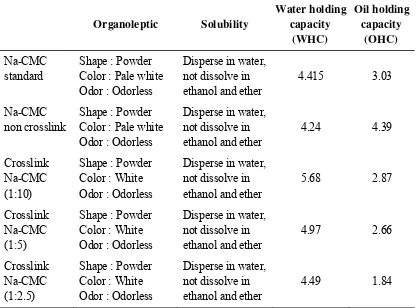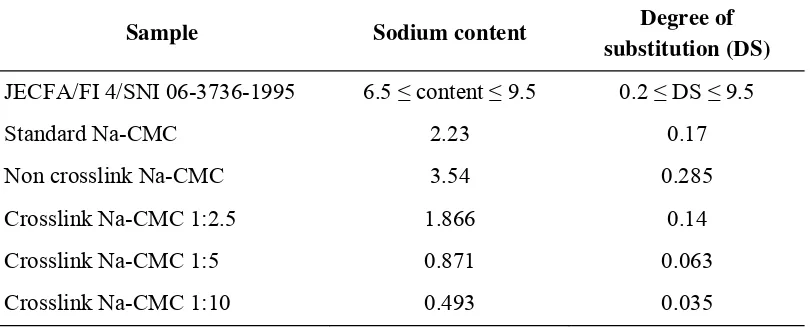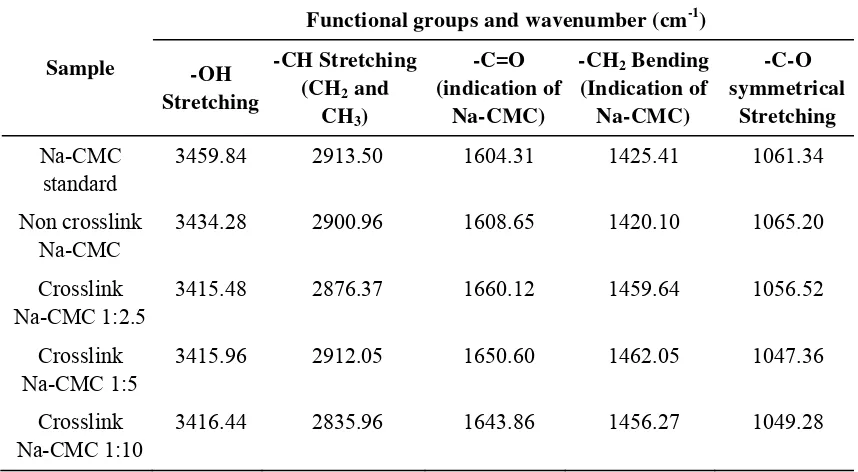________________________________________
*
Author for correspondence; E-mail: aliya_nh@yahoo.com
www.sadgurupublications.com
EPICHLOROHYDRIN AS CROSSLINKING AGENT FOR
SYNTHESIS OF CARBOXYMETHYL CELLULOSE
SODIUM (Na-CMC) AS PHARMACEUTICAL
EXCIPIENT FROM WATER HYACINTH
(
EICHORRNIA CRASSIPES
L.)
ALIYA NUR HASANAH
*, INGGHEA ELYANI, SRIWIDODO
a,
MUCHTARIDI, AHMAD MUHTADI
band IDA MUSFIROH
Pharmaceutical Analysis and Medicinal Chemistry Department, Faculty of Pharmacy, Universitas Padjadjaran, Jl Raya Bandung Sumedang KM 21,5 JATINANGOR
a
Pharmaceutical Technology Department, Faculty of Pharmacy, Universitas Padjadjaran, Jl Raya Bandung Sumedang KM 21,5 JATINANGOR
b
Pharmacology and Clinical Pharmacy Department, Faculty of Pharmacy, Universitas Padjadjaran, Jl Raya Bandung Sumedang KM 21,5 JATINANGOR
ABSTRACT
Water hyacinth is a plant, which contain high cellulose concentration that potential to be used as raw material for carboxymethylcellulose sodium. This study was conducted to observed the influence of crosslinker epichlorohydrin to the value of water holding capacity (WHC) and oil holding capacity (OHC) of carboxymethyl cellulose sodium synthesized from water hyacinth (Eichhornia crassipes (Mart.) Solm.). Research conducted through α-cellulose isolation, synthesis of Na-CMC, crosslinking Na-CMC, and characterization. The results showed α-cellulose yield of 26.334% and Na-CMC crosslink 150%. Physical quality evaluation of Na-CMC synthesized results and Na-CMC crosslink shows the most effective crosslink is in comparison 1:10. The value of WHC and OHC from Na-CMC, non crosslink Na-CMC and crosslink Na-CMC consecutively are 4.24 g/g and 4.39 g/g, 4.415 g/g and 3.03 g/g, 5.68 g/g and 2.87 g/g. Based on the study, epichlorohydrin can be used as a crosslinker in synthesis of Na-CMC from cellulose of water hyacinth for pharmaceutical application.
Key words: Carboxymethylcellulose sodium, Crosslink, Epichlorohydrin, α-Cellulose, Water hyacinth.
INTRODUCTION
64.5% of cellulose. This cellulose contain was high enough to be used as raw material for sodium carboxymethyl cellulose. Research conducted by Musfiroh et al.2 have produced the Na-CMC from cellulose of water hyacinth, which meet pharmaceutical excipients parameter from USP NF 30 and Handbook of excipients but it still has shortcomings on the value of the degree of substitution (DS), water holding capacity (WHC), and oil holding capacity (OHC) compared with the standard. The degree of substitution of the analytical results for the Na-CMC derived from cellulose of hyacinth is at 0.7. While the value of the degree of substitution for Na-CMC in general is at 0.5-1.53. WHC and OHC values for Na-CMC derived from cellulose of hyacinth was smaller than Na-CMC standard, the WHC value for synthesis is 2.3585 g/g and 5.2184 g/g for standard while OHC value is 1.64 g/g for synthesis and 2.38 g/g for standard. According to Basmal et al.4, the value of the degree of substitution will affect the process of etherification of cellulose with sodium monochloroacetate, which in turn will affect the number of carboxymethyl groups generated. WHC and OHC value will affect the viscosity of the resulting Na-CMC.
One technique to improve the DS value, WHC and OHC is through the addition of crosslinker agent5. Crosslinker will improve the structure of Na-CMC polymer by forming bonds on the polymer so that it will be more stable and will produce Na-CMC with high viscosity. Crosslinker is a compound that can form chemical bond and linking the polymer chains with other polymer. Using crosslinker in the synthesis will change the straight chain into crosslinked structure so the resulting structure will have stronger structure and hard to retrodegraded6. Crosslinker will affect the physical properties of polymer such as reducing elasticity of the polymer, increasing the molecular weight, and improve the stability of the polymer. There are a wide variety of crosslinker that is often used in the manufacture of
pharmaceutical preparations, such as methylene diphenylene diisocyanate (MDI), N, N'-methylene bisacrylamide (MBA) and epichlorohydrin7-9. Epichlorohydrin crosslinker
is often used in cellulose10,11. These compounds form of a solution that is colorless and odorless, carcinogenic, slightly soluble in water but soluble in polar solvents12. Epichlorohydrin has a small molecular weight and is normally used in the manufacture of solvents and surfactants on pharmacists13.
EXPERIMENTAL
Instrumentation that used in this study were digital scales (Mettler Toledo), grinding machines, magnetic stirrer (Yellow MAG HS7), 50 mesh sieve, oven (Heraeus), pH meter (Mettler Toledo), a water bath (memmert), electric furnace, Fourier Transform Infrared (FTIR) (Shimadzu, IR Prestige-21), and glass tools that commonly used in laboratories. The materials used in this study are the water hyacinth, distilled water, sodium hydroxide (NaOH) (Bratachem), sodium hypochlorite (NaOCl) (Bratachem), potassium dichromate (K2Cr2O7),
sulfuric acid (H2SO4) acid (Merck), an indicator Ferroin, ferrous ammonium sulfate
[(NH4)2Fe (SO4)2.6H2O], isopropyl alcohol (Bratachem), sodium monochloro acetate
(NaCH2COOCl) (Sigma Aldrich), methanol (Merck), ethanol (Bratachem), nitric acid
(HNO3), silver nitrate (AgNO3), ammonium thiocyanate (Merck), acetic acid (CH3COOH)
glacial (Merck), alpha-naphthol (Merck), and epichlorohydrin (Merck).
The water hyacinth used were obtained from the Jatiroke, Jatinangor, West Java, Indonesia. The roots of the water hyacinth taken was discarded, then washed with water to remove mud attached and dried under the sun for 5-7 days. After it dried, the hyacinth is crushed into a coarse powder form, and dried again in the oven at 95oC for 12 hrs, and sieved to 50 mesh2.
Isolation of α-Cellulose from water hyacinth was conducted according to early research using NaOH 25%2. The water hyacinth grain was first boiled with water, and filtered. The insoluble part was boiled again with sodium hydroxide for one hour, and then filtered. The residue from this process was then washed with aquadestillata until the pH level reaching 6-7. The cleaned residue was then put into a plastic container, and the natrium hypochlorite (NaOCL) bleaching solution was further added to the residue. Both the residue and the solution were stirred evenly for 4 hrs in the closed container. The result was then filtered and again washed using aquadestillata until the chlorine scent was thoroughly undetectable. It was dehydrated in the oven at 50oC. The final residue was called α-cellulose. The α-cellulose content then was analyzed by using titrimetry method in accordance with SNI 0444:2009 code6 of conduct concerning alpha, beta and gamma cellulose in pulp examination method14.
stirring process was then continued by slowly adding sodium monochloroacetate (ClCH2COONa) for 30 mins, and after the addition the stirring process was continued for
3.5 hrs at 55oC. In the second step, 70% methanol was added to the reactor and the mixture was neutralized with 90% acetic acid. Na-CMC was thus obtained by washing and filtering the residue 6 times using ethanol. The obtained Na-CMC through ethanol cleaning was then washed again with pure methanol and dehydrated in the oven at 60%.
Crosslinking step of resulted Na-CMC was done in different variation of Na-CMC: Epichlorohydrin (1: 2.5; 1: 5; 1:10) 5 g of Na-CMC were mixed with 50 g of 17.5% NaOH and stirred at 50oC for 20 min. Epichlorohydrin in 28% NH4OH in the ratio 1: 2.5; 1: 5; 1:10
to Na-CMC were added. The mixture then put in the reflux apparatus for 4 hrs at 40oC. Na-CMC that already crosslink then washed with ethanol and water, and then dried.
Characterization of crosslink Na-CMC was done according to SNI 06-3736-1995, The Joint FAO/WHO Expert Committee on Food Additives (JECFA)15,16. The characterization include :
(a) Organoleptic: Examining the shape, color, smell, and taste according to the Indonesian Pharmacopoeia 4th edition.
(b) Solubility: The sample is weighed three times as much as 0.1 g then dissolved in distilled water, ethanol, and ether.
(c) Water holding capacity (WHC) and oil holding capacity (OHC) determination: Distilled water and 25 mL of olive oil are added each to 1 g sample of crosslink Na-CMC, then stirred with a mechanical stirrer while incubated at 40°C for 1 hr. WHC and OHC values are calculated as a gram per gram sample17.
(d) Determination of the degree of substitution (DS). The determination of the degree of substitution is performed by calculating the content of sodium in the Na-CMC and multiply with a factor.
Degree of substitution = 162 x % sodium/2300- (80 x % sodium).
(e) Characterization of crosslink Na-CMC with instrument method. The characterization of Na-CMC synthesized from water hyacinth cellulose was done by using fourier transform infrared (FTIR).
RESULTS AND DISCUSSION
remove mud attached and dried under the sun for 5-7 days. Drying shrinkage of the materials then was determined, the results can be seen in Table 1.
Table 1: Drying shrinkage of water hyacinth results
Wet weight (Kg) Dry weight (Kg) Drying shrinkage (%)
5.19 0.492 90.52
After drying shrinkage determination, the water hyacinth sample was milled to form a coarse powder. Milling goal is to minimize the size of cellulosic materials and breaks down chemical bonds in long-chain molecules3. After that, the hyacinth is crushed into a coarse powder form, and dried again in the oven at 95oC for 12 hrs, and sieved to 50 mesh2.
The isolation of α-Cellulose from water hyacinth was conducted according to early research using NaOH 25%2. The water hyacinth grain was first boiled with water, and filtered. The insoluble part was boiled again with natrium hydroxide for one hour, and then filtered. The residue from this process was then washed with aquadestillata until the pH level reaching 6-7. This process was performed because this material will be use for pharmaceutical application so it should be in a neutral pH. The cleaned residue was then put into a plastic container, and the natrium hypochlorite (NaOCl) bleaching solution was further added to the residue. Both the residue and the solution were stirred evenly for 4 hrs in the closed container. The result was then filtered and again washed using aquadestillata until the chlorine scent was thoroughly undetectable. It was dehydrated in the oven at 50oC. The final residue was called α-cellulose. The α-cellulose obtained from this procedure was 26,33%. This is not large enough because the washing process made a lot of loosing.
α-cellulose content analysis was performed according to SNI 0444: 2009 on how to test the levels of alpha, beta, and gamma cellulose in the pulp. The method used was back titration, where what counts is the content of - -cellulose and cellulose. At this titration, we used boiling potassium dichromate (K2Cr2O7) in an excess acid in order to oxidize the
cellulose. Residual potassium dichromate, which has reacted with -cellulose and cellulose- will be determined by titration using indicators ferroin as an indicator. The reaction was at follows :
6 Fe2+ + Cr2O72− + 14 H+ ⎯⎯→ 6 Fe3+ + 2 Cr3+ + 7 H2O
immersion in 25% NaOH solution, higher concentration of NaOH can affected to number of
α-cellulose being isolated. In addition, the high content of α-cellulose is also caused by the bleaching process that can also increase the levels of α-cellulose contained in the sample.
The Na-CMC synthesis of water hyacinth α-cellulose was done with the ratio as follows: isopropyl alcohol: NaOH: sodium monochloroacetate (1:1:0.25) according to Musfiroh et al.2 Sodium carboxymethyl cellulose (Na-CMC) was synthesized in two-step reactions. In the first step, the cellulose was put in the suspension process by stirring it with isopropyl alcohol using a mechanical stirrer at room temperature; NaOH 40% was also added in the stirring process. This mixture was stirred for 90 mins, and the result was alkali cellulose. The stirring process was then continued by slowly adding natrium monochloroacetate (ClCH2COONa) for 30 min, and after the addition the stirring process
was continued for 3.5 hrs at 55oC. At this stage of reaction, in addition to the formation of Na-CMC occurs also occur formation of by products in the form of sodium glycolate and sodium chloride (NaCl). Thereafter, 70% methanol was added to the reactor. Then the mixture was neutralized with 90% acetic acid to remove the glycolic acid. Na-CMC was then obtained by filtering and washing the residue 6 times with ethanol. Na CMC that has been washed with ethanol then washed again with pure methanol and dried using an oven at 60°C3. At this stage, carboxymethyl cellulose into cleaner (seen from its physical appearance). This washing step causes the content of isopropyl alcohol in the Na-CMC decreased to 5%.
Crosslinking step of resulted Na-CMC was done in different variation of Na-CMC : Epichlorohydrin (1: 2.5; 1: 5; 1:10) 5 g of Na-CMC were mixed with 50 g of 17.5% NaOH and stirred at 50C for 20 min. This heating stage serves to accelerate the reaction between Na-CMC and 17.5% NaOH. Epichlorohydrin in 28% NH4OH in the ratio 1: 2.5; 1: 5; 1:10 to
Na-CMC were added. Epichlorohydrin serves as an agent that will form Na-CMC crosslinks. NH4OH 25% made an alkaline condition in a crosslink process, besides NH4OH also useful
as long chain-forming bonds at crosslinking. The mixture then put in the reflux apparatus for 4 hours at 40oC. This process is useful to break Na-CMC bonds and form a bond between the Na-CMC and epichlorohydrin. Na-CMC that already crosslink then washed with ethanol and water, and then dried.
Table 2: Quality test results of crosslink Na-CMC, non crosslink Na-CMC and
Based on Na-CMC monograph that is written in the Indonesian Pharmacopoeia fourth edition. Na-CMC will form a colloidal solution with the addition of water, but insoluble by the addition of ether and ethanol. Crosslink Na-CMC showed the result of solubility that meet with the criteria. The solubility of Na-CMC is influenced by the degree of substitution (DS) value. Na-CMC with DS is less than or equal to 3 is soluble in alkaline solution, whereas the DS greater than 0.45 dissolved in water18.
crosslink Na-CMC, it can be seen that the higher the amount of crosslinker used, the higher the value of WHC. This is because more chemical bond can be formed by the crosslinker. OHC value of crosslink Na-CMC smaller than the standard, this is may be due to with the type of cellulose in the crosslink Na-CMC. Higher number of amorphous cellulose can absorb more water4.
Degree of substitution also determines in this study according to SNI 06-3736-199515. Results of the analysis of the degree of substitution (DS) for the Na-CMC standard is 0.17, while non crosslink Na-CMC is 0.285. Crosslink Na-CMC with composition 1: 2.5;
1: 5; 1:10, gives DS value 0.14, 0.063, and 0.035, respectively. DS value of crosslink Na-CMC was smaller than the standard and non crosslink, this is because crosslinking
process will decreasing water solubility of a compound and degree of substitution. More crosslinker is added to the Na-CMC will further decrease the solubility and the degree of substitution19.
Table 3: Sodium content and degree of substitution value of standard Na-CMC, non crosslink Na-CMC and crosslink Na-CMC
Sample Sodium content Degree of substitution (DS)
JECFA/FI 4/SNI 06-3736-1995 6.5 ≤ content ≤ 9.5 0.2 ≤ DS ≤ 9.5
Standard Na-CMC 2.23 0.17
Non crosslink Na-CMC 3.54 0.285
Crosslink Na-CMC 1:2.5 1.866 0.14
Crosslink Na-CMC 1:5 0.871 0.063
Crosslink Na-CMC 1:10 0.493 0.035
Based on the results of the FTIR analysis, characteristic absorption peaks are at wave number 3415.48 to 3459.84 cm-1 (absorption peak of OH group), and the wave number 1047.36 to 1065.20 cm-1 (CO absorption peaks), which shows the glycoside bond in the structure of Na-CMC. Crosslink Na-CMC in different composition, has the same infra red spectrum as the standard.
Table 4: FTIR spectrum results of standard Na-CMC, non crosslink Na-CMC and crosslink Na-CMC
Sample
Functional groups and wavenumber (cm-1)
-OH
3459.84 2913.50 1604.31 1425.41 1061.34
Non crosslink Na-CMC
3434.28 2900.96 1608.65 1420.10 1065.20
Crosslink Na-CMC 1:2.5
3415.48 2876.37 1660.12 1459.64 1056.52
Crosslink Na-CMC 1:5
3415.96 2912.05 1650.60 1462.05 1047.36
Crosslink Na-CMC 1:10
3416.44 2835.96 1643.86 1456.27 1049.28
Based on the research that has been done crosslinking can improve the value of WHC and OHC of Na-CMC and reduce the degree of substitution of Na-CMC. Comparison of effective crosslinker used in the Na-CMC was 1:10 against the amount of Na-CMC.
ACKNOWLEDGMENT
Directorate of Higher Education Indonesia for funding this research through PUPT Grant of Universitas Padjadjaran 2015.
REFERENCES
2. I. Musfiroh, A. N. Hasanah and I. Budiman, Res. J. Pharmaceut. Biol. Chem. Sci.,
4(4), 1092-1099 (2013).
3. A. Latif, Anwar and S. Noor, J. Chem. Soc. Pak., 29(2), 143-150 (2007).
4. J. Basmal, A. Dina and Dan Sediarso, J. Penelitian Perikanan Indonesia, 11(4), 61-69 (2005).
5. M. A. Adel, H. Zeinab, E. W. Abd, A. I. Atef and T. A. Mona, Cellulose and Paper Department, National Research Centre, Cairo, Egypt (2010).
6. O. B. Wuzburg, Modified Starches : Properties and Uses, CRC Press, Inc. Boca Raton. Florida (1986).
7. M. B. Ahmad, K. B. Hashim, N. Mohd Yazid and N. Zainuddin, J. Sci. Technol.,
20(2), 425-433 (2012).
8. M. A. Adel, H. Zeinab, E. W. Abd, A. I. Atef and T. A. Mona, Cellulose and Paper Department, National Research Centre. Cairo. Egypt (2010).
9. M. V. Pergal, V. V. Antic, O. Sanja, M. C. Milena and D. Jasna, J. Serbian Chem. Soc., 77(7), 919-935 (2012).
10. J. A. Laszlo and F. R. Dintzis, J. Appl. Polym. Sci., (52), 531-538 (1994).
11. A. M. A. Nada and M. Adel Abeer, J. App. Polym. Sci., 105, 412-419 (2007).
12. J. E. Amoore and E. Hautala, Odor as an Aid to Chemical Safety: Odor Thresholds Compared with Threshold Limit Values and Volatilities for 214 Industrial Chemicals in Air and Water Dilution, J. Appl. Toxicol., 3(6), 272-290 (1983).
13. U. S. Environmental Protection Agency, Health and Environmental Effects Profile for Epichlorohydrin. EPA/600/x-85/400, Environmental Criteria and Assessment Office, Office of Health and Environmental Assessment, Office of Research and Development, Cincinnati, OH (1985).
14. Standar Nasional Indonesia, Cara Uji Kadar Selulosa Alfa, Beta Dan Gamma Dalam Pulp (SNI 0444: 2009), Jakarta: Badan Standardisasi Nasional (2009).
15. Standar Nasional Indonesia, Cara Uji Natrium Karboksi Metil Selulosa Teknis (SNI 06-3736-1995), Jakarta: Badan Standardisasi Nasional (1995).
16. JECFA, Sodium Carboxymethyl Cellulose, Available at http://www.fao. org/ag/agn/ jecfa-additives/specs/Mono graph1/additive-396-m1.pdf. (1984).
18. P. E. Bouton, P. V. Harris and W. R. Shorthose, J. Food Sci., 36(3), 435-439 (2006).
19. S. Tanaka, J. Aketagawa, S. Takahashi, Y. Shibata, Y. Tsumuraya and Y. Hashimoto, Carbohydr. Res., 218, 167-174 (1991).
20. H. D. Heydarzadeh, G. D. World Appl. Sci. J., 6(4), 564-569 (2009).


